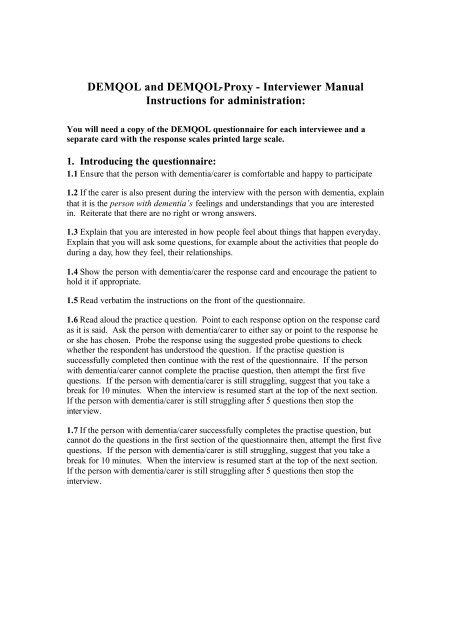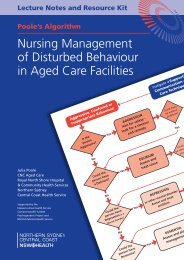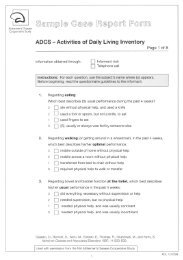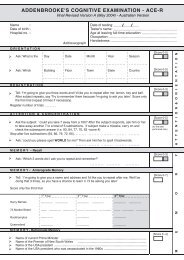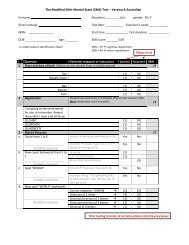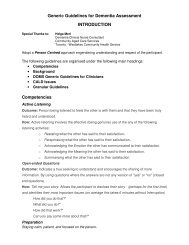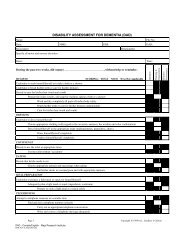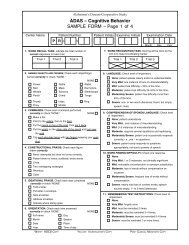DEMQOL And DEMQOL-Proxy – Interviewer Manual Instructions For
DEMQOL And DEMQOL-Proxy – Interviewer Manual Instructions For
DEMQOL And DEMQOL-Proxy – Interviewer Manual Instructions For
You also want an ePaper? Increase the reach of your titles
YUMPU automatically turns print PDFs into web optimized ePapers that Google loves.
<strong>DEMQOL</strong> and <strong>DEMQOL</strong>-<strong>Proxy</strong> - <strong>Interviewer</strong> <strong>Manual</strong><br />
<strong>Instructions</strong> for administration:<br />
You will need a copy of the <strong>DEMQOL</strong> questionnaire for each interviewee and a<br />
separate card with the response scales printed large scale.<br />
1. Introducing the questionnaire:<br />
1.1 Ensure that the person with dementia/carer is comfortable and happy to participate<br />
1.2 If the carer is also present during the interview with the person with dementia, explain<br />
that it is the person with dementia’s feelings and understandings that you are interested<br />
in. Reiterate that there are no right or wrong answers.<br />
1.3 Explain that you are interested in how people feel about things that happen everyday.<br />
Explain that you will ask some questions, for example about the activities that people do<br />
during a day, how they feel, their relationships.<br />
1.4 Show the person with dementia/carer the response card and encourage the patient to<br />
hold it if appropriate.<br />
1.5 Read verbatim the instructions on the front of the questionnaire.<br />
1.6 Read aloud the practice q uestion. Point to each response option on the response card<br />
as it is said. Ask the person with dementia/carer to either say or point to the response he<br />
or she has chosen. Probe the response using the suggested probe questions to check<br />
whether the respondent has understood the question. If the practise question is<br />
successfully completed then continue with the rest of the questionnaire. If the person<br />
with dementia/carer cannot complete the practise question, then attempt the first five<br />
questions. If the person with dementia/carer is still struggling, suggest that you take a<br />
break for 10 minutes. When the interview is resumed start at the top of the next section.<br />
If the person with dementia/carer is still struggling after 5 questions then stop the<br />
interview.<br />
1.7 If the person with dementia/carer successfully completes the practise question, but<br />
cannot do the questions in the first section of the questionnaire then, attempt the first five<br />
questions. If the person with dementia/carer is still struggling, suggest that you take a<br />
break for 10 minutes. When the interview is resumed start at the top of the next section.<br />
If the person with dementia/carer is still struggling after 5 questions then stop the<br />
interview.
2. Administering the questionnaire items:<br />
2.1 Read each question exactly as it is written. If there is an example in the question, this<br />
must always be read too. Read aloud each response option, pointing to each response as<br />
you say it.<br />
2.2 When the person with dementia/carer has indicated his or her response, mark it on the<br />
questionnaire. Mark only one response for each question. If the patient does not or<br />
cannot answer an item (for any reason), record the response as missing.<br />
2.3 Try not to prompt with the phrase “so that doesn’t worry you at all? ” as this<br />
encourages a yes/no answer. Instead use the phrase “how much does that worry you?”<br />
and repeat the four response options.<br />
2.4 <strong>For</strong> each question read both the stem and the item content. If the person has difficulty<br />
with an item repeat both the stem and the item verbatim. If they still have difficulty then<br />
repeat second part of the stem (ie “..are you worried about”) and the item content.<br />
2.5 At the end of the interview go back to any missed items and if appropriate ask the<br />
person with dementia/carer to complete them.<br />
3. De-briefing after the interview:<br />
3.1 Explain that all the questions have now been answered.<br />
3.2 Ask whether person with dementia/carer has any questions that he or she would like<br />
to ask. Answer any questions and thank the person with dementia/carer for taking part<br />
4. Possible queries and responses - general:<br />
4.1 doesn’t want to complete the questionnaire<br />
Tell the person with dementia/carer that participation is entirely voluntary. They are<br />
being asked to complete the questionnaire because it will help us to understand more<br />
about what people think is important for quality of life. If they still do not want to<br />
participate stop the interview and thank the person with dementia/carer.<br />
4.2 stops completing the questionnaire because he/she does not understand<br />
Specific prompts for not understanding or querying are given on the next page. In<br />
general if the person with dementia/carer does not understand a particular question, reread<br />
it verbatim, but do not re-phrase the question. If the person with dementia/carer<br />
does not understand the response options, re-read the response options verbatim but do<br />
not re-phrase them. The question and the response options can be re-read as many times
as is necessary, but if it is clear that the patient or carer does not understand then do not<br />
continue.<br />
4.3 is concerned that someone will look at his/her answers<br />
Reassure the patient/carer that all of his/her responses will be kept confidential to the<br />
research team. Explain that names will be replaced by a study number so that the<br />
questionnaires are completely confidential.<br />
4.4 asks you to interpret a question<br />
Specific prompts for not understanding or querying are given on the next page. In<br />
general re-read the item verbatim. Do not try to explain an item. Suggest that the person<br />
with dementia/carer base his/her answer on what he/she thinks the question means. Rephrasing<br />
or interpreting a question can bias results. It is very important that the questions<br />
are read verbatim and only the standard prompts are used (see specific prompts given on<br />
next page).<br />
4.5 answers “don’t know” or wants to miss out a question<br />
Acknowledge that it can be hard to choose a response, but encourage the patient/carer to<br />
choose the response option that most applies to him/her. If a patient/carer wants to miss<br />
out an item, explain to the patient/carer that all the questions are very important. They<br />
should try to answer all of the questions. If the patient/carer still does not want to answer<br />
a particular item, assure the patient that it is alright, then go on to the next item.<br />
4.6 wants to know the meaning of his/her answers<br />
Tell the patient/carer that all information is helpful and that there are no right or wrong<br />
answers. Remind the patient/carer that all the information is kept confidential and that<br />
we will look at what everybody says together rather than anybody’s questionnaire on its<br />
own.<br />
4.7 asks why both patient and carer must complete the questionnaire<br />
Explain that sometimes patients and carers have a different view. Both are useful and by<br />
asking questions to both carer and patient we can get a more complete picture of how<br />
people feel.
5. Possible queries and responses <strong>–</strong> specific:<br />
5.1 if person answers simply “yes” instead of choosing one of the four response<br />
options:<br />
• repeat the response options and ask him/her to choose one<br />
• if still say “yes”, ask him/her to choose from one of the three positive<br />
response options (ie a lot, quite a bit or a little) and record the one that they<br />
choose<br />
• if still not clear which response option he/she means, repeat the three positive<br />
options again and record the one that he/she chooses<br />
• if the person says two positive response options ask them to choose one and<br />
record it<br />
• if necessary repeat the question verbatim<br />
5.2 if person answers simply “no” instead of choosing one of the four response<br />
options:<br />
• repeat the response options and ask him/her to choose<br />
• if the person still just says “no” check with him/her if that would be “not at<br />
all”<br />
• if necessary repeat the question verbatim<br />
5.3 if person responds using their own phrase or form of words that is not one of<br />
the response options:<br />
• repeat the question and the response options verbatim and ask them to choose<br />
one of the response options<br />
• if they still don’t use one of the response options but are answering in a way<br />
that is relevant to the question, reiterate that they need to choose one of the<br />
four response options<br />
• if they still don’t choose one of the response options, then accept their answer,<br />
but don’t score it, mark the questionnaire as missing and move on to the next<br />
questions<br />
5.4 if person responds using the phrase “not a lot”:<br />
• ask if they mean “a little” or “not at all” and record the answer given<br />
• if the person is unable to choose between these two options then accept their<br />
response but don’t score it. Record the item as missing and allocate the<br />
appropriate code. Move on to the next question.
5.5 if person misunderstands question (ie answering something else entirely):<br />
• repeat question and response options<br />
• if the person still appears not to understand the question go on to the next<br />
question<br />
5.6 if person explicitly queries what a question means:<br />
• do not re-phrase or interpret any question<br />
• repeat question and response options verbatim<br />
• suggest that he/she bases their answer on what he/she think it means<br />
• if the person is still querying or appears not to understand go on to the next<br />
question and reassure him/her that they’re doing very well and its fine to go<br />
on to the next question<br />
5.7 if person refuses to answer a question:<br />
• accept his/her refusal and reassure the person that it is alright not to answer.<br />
Go on to the next question.<br />
5.8 if person answers in terms of ability/functioning rather than subjective<br />
perception:<br />
• accept his/her answer and then ask how much he/she worries about that<br />
particular activity and repeat the response options.<br />
5.9 if carer queries a” feeling” question saying that they cannot know:<br />
• tell the carer that there is probably noone else who knows the person better.<br />
They should just give the answer that best describes how they think their<br />
relative has felt.<br />
5.10 if person doesn’t understand the general QoL question at the end:<br />
• repeat descriptive sentence in question book and repeat question<br />
• if the person still appears not to understand say “In the last week how would<br />
you rate your quality of life overall? ”<br />
• if the person still appears not to understand say “thinking about your life in the<br />
last week would you say it was….very good, good, fair or poor?”<br />
• if still not able to answer accept the non-response, assure the person that it is<br />
alright and thank him/her for taking part


